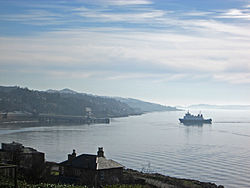Wemyss Bay
| Wemyss Bay | |
| Renfrewshire | |
|---|---|
 Wemyss Bay from Cliff Terrace Road | |
| Location | |
| Grid reference: | NS195695 |
| Location: | 55°53’2"N, 4°53’13"W |
| Data | |
| Post town: | Wemyss Bay |
| Postcode: | PA18 |
| Dialling code: | 01475 |
| Local Government | |
| Council: | Inverclyde |
| Parliamentary constituency: |
Inverclyde |
Wemyss Bay is a village on the coast of the Firth of Clyde, in Renfrewshire. It is adjacent to Skelmorlie, across in Ayrshire: the two counties are here divided by the Kelly Burn.
Wemyss Bay is the port for ferries to Rothesay on the Isle of Bute. Passengers from the island can connect to Glasgow by trains, which terminate in the village at the remarkable Wemyss Bay railway station, noted for its architectural qualities and regarded as one of Britain’s finest railway buildings.[1][2] The port is very exposed, so in high winds the ferries must travel up river to Gourock to dock.
Name
The name Wemyss is pronounced ‘[weemz]’. The name is not native to the coast and it is not known from whom the town is named, but it is suggested that it is from Bob Wemyss, who was the owner of a hut on the shore in the 19th century.[3]
The name “Wemyss” is mor often associated with Fife, and the lands of the Earls of Wemyss, who take their title from the Gaelic uaimh which means cave.[4] It is believed to be taken from the caves of the Firth of Forth where the Clan Wemyss made their home.
History
Wemyss Bay was created in the early 19th century as a 'marine village' and watering-place by Robert Wallace of Kelly, whose lands were adjacent to the bay. Wallace became Greenock's first member of Parliament and was instrumental in establishing the penny post. London merchant James Alexander further developed the area by constructing the first steamboat pier, which was swept away by a hurricane in 1856. Its successor suffered a similar fate and was replaced by the current railway terminus and pier.
The opening of the railway connection in 1865 brought even grander houses. Among the village's notable residents included Sir George Burns, who with Samuel Cunard founded the British and North American Royal Mail Steam Packet Company (later the Cunard Line), and his son John (later 1st Baron Inverclyde) who lived at Castle Wemyss, which stood on Wemyss Point above the bay itself.
Kelly Estate
The industrial magnate James "Paraffin" Young had a house at Kelly, and was buried in the old Inverkip churchyard; his fortune came from his investion of an efficient method of extracting paraffin from shale. David Livingstone was a friend of Young, and a replica of a hut which Livingstone occupied near Victoria Falls was built in the grounds of Kelly as a memorial to the explorer. Kelly House was rebuilt twice, the first structure dating from the 15th century,[5] being destroyed by fire in 1740, the second, a William Leiper building, dating from 1793 and the third and final house also destroyed in a fire in 1913, only having been built in 1890.[6] Blame was laid at the suffragettes but no evidence was ever found. Kelly remained a burnt out ruin for several years. A caravan park now occupies the estate.
Other notable buildings
A memorial on the shore road recalls 'The Gaiter Club', whose members included Anthony Trollope, Lord Kelvin, Lord Palmerston and the Earl of Shaftesbury.[7]
Neither Castle Wemyss nor James Salmon's Wemyss House remain, having been demolished in the 1980s and 1940s respectively. Also gone is J J Burnet's episcopal Inverclyde Church, which stood on the shore road of Undercliff Road and was demolished in 1970.[8]
The Castle Wemyss estate and adjoining areas had been sold off in the 1960s to property developers and since then the village has grown considerably, albeit largely a commuter village for Greenock and Glasgow. However several of the fine red sandstone properties remain and are now seen as renovation opportunities. There is a butcher, newsagent, café and fish and chip shop in the village and a pub and café in the extensive railway station buildings.
Outside links
| ("Wikimedia Commons" has material about Wemyss Bay) |
References
- ↑ Walker, Frank Arneil (1986) The South Clyde Estuary, RIAS.
- ↑ Edwards, Brian (1986), Scottish Seaside Towns, BBC Publications
- ↑ Wemyssbay.net
- ↑ Way, George and Squire, Romily. Collins Scottish Clan & Family Encyclopedia. (Foreword by The Rt Hon. The Earl of Elgin KT, Convenor, The Standing Council of Scottish Chiefs). Published in 1994. Pages 342 - 343.
- ↑ http://www.discoverinverclyde.com/historical-interest.aspx
- ↑ CANMORE (RCAHMS) record of Kelly House
- ↑ Smart, Walter (1968) Skelmorlie
- ↑ Bertie, David M. (2001) Scottish Episcopal Clergy 1689-2000, T&T Clark, p. 658
- Smart, Walter: Skelmorlie (1968) - an account of both Wemyss Bay and Skelmorlie
- Gourock, Inverkip and Wemyss Bay from Old Photographs (1981)
- Gourock, Inverkip and Wemyss Bay in Old Picture Postcards (1998)
